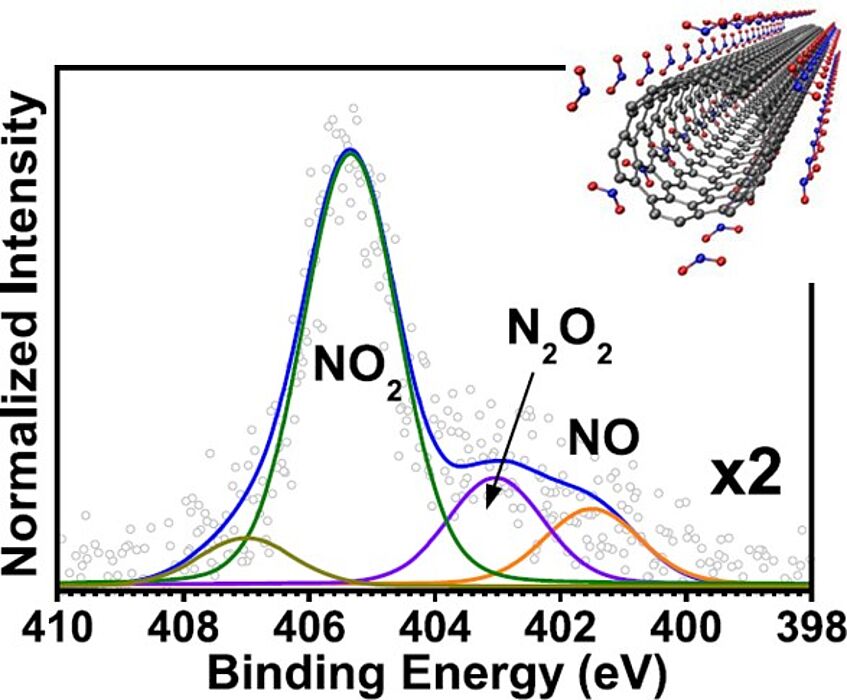«Electron and Spin Correlations in Nano Carbon-Metal Hybrids»
Our main field of research concerns carbon nanotubes. As the name implies, these are tube like structures made entirely of carbon with a diameter close to 1 nanometer but lengths reaching centimeters and more, making them quasi one-dimensional. Depending on their diameter and how they are “twisted”, they can have different electronic and optical properties, ranging from metallic to semiconducting behaviour. While the carbon nanotubes’ quasi one-dimensionality is the underlying cause for observing unfamiliar physics, their hollow core is able to serve as a host for other molecules and even provide a safe haven for otherwise highly unstable ones. Thusly, through the interaction between host and filler, new physical phenomena can be unravelled while simultaneously new areas of chemistry are unlocked.
![[Nano1]](/fileadmin/_processed_/csm_PICHLER_what-do-I-study_8073394a9e.png)
Zooming into the realm of nanometer sized objects. The insets show a magnification of the tube, a simulated image and a model of this structure. Scale bar on the lower left is 2 Nanometer.
The pictures emulate the zooming into the realm of nanometer sized objects. The first picture shows a large chunk of a carbon nanotube sample, where myriads of entangled carbon nanotubes form a sheet-like structure, while their colour resembles charcoal. This entanglement originates from the carbon nanotubes’ tendency to form bundles with other nanotubes, which is depicted by the threads in the second picture, resulting in a meander-like appearance.
Eventually, the third picture shows an individual, double-walled carbon nanotube. Its hollow core is filled with carbyne, a one-dimensional chain of carbon atoms linked to each other. Carbyne was only recently discovered by our group, as longer and longer carbon chains become extremely unstable and therefore almost impossible to observe in nature, but carbon nanotubes are able to provide the necessary stability.
Due to their structure and electronic properties, carbon nanotubes can be applied in many different fields. Their small size allows for pushing the boundaries of nanotechnology, building smaller electronic parts than it would be possible for standard materials like silicon. Their optical properties facilitate the usage as tracer material in biological systems but also e.g. for photovoltaic purposes, i.e. solar cells. Their tube-like structure results in a high surface to volume ratio, making carbon nanotubes ideal candidates for gas sensing purposes, even at extremely low doses.
Spectrometer
The picture shows partially the interior of a spectrometer where laser light is guided through a system of mirrors and filters to a carbon nanotube sample underneath a microscope, so that every other light source is cut off and the response of the carbon nanotubes to this very specific wavelength/frequency can be recorded with high accuracy.
![[Nano2]](/fileadmin/_processed_/csm_labram_d37fec14c4.jpg)
In the shown case, a so called Raman spectrometer is used to gain structural informations via thevibrational modes of a sample that cause a shift in the original laser frequency.
A conceptually similar machine is also used to observe a samples’ fluorescence, as different kinds of nanotubes absorb light at a different high frequency and emit light at a different low frequency, meaning that every type of nanotube has its own set of resonance conditions.
Other investigated properties include the absorption of light by carbon nanotubes, or, in a more sophisticated manner, the photoemission effect. For the latter, the nanotubes are bombarded with light of much higher frequency like UV or X-Rays so that electrons can be shot out from the carbon atoms and be investigated.
![[Nano3]](/fileadmin/_processed_/csm_NANO_1.Pichler-_-Inhalt-004__1__63bfd3b40b.jpg)
Band gaps
Carbyne has optical properties that depend on the length of the carbon chains. The numbers above the curves stand for the respective vibrational frequency, correlated to the length of the carbon chains as these are bombarded with laser light. Not only do longer chains exhibit a lower frequency, we also found that the longest chains require a lower laser energy.
The as-mentioned filler material carbyne has optical properties that depend on the length of the carbon chains. The numbers above the curves stand for the respective vibrational frequency that is correlated to the length of the carbon chains, with longer chains exhibiting a lower frequency. We found, that their electronic resonance shows the same relationship, with the longest chains requiring a lower laser energy.
Luminescence
The fluorescence intensity of carbon nanotubes can be improved, on the left (red and green) by filling with carbyne, on the right (black) with a molecule called ferrocene. As these molecules have different sizes, differently thick nanotubes are affected differently by the interaction between host and molecule.
![[Nano2]](/fileadmin/_processed_/csm_NANO_1.Pichler-_-Inhalt-005_d7b084c056.jpg)
fluorescence
The fluorescence intensity of carbon nanotubes can be improved, on the left (red and green) by filling with carbyne, on the right (black) with a molecule called ferrocene. As these molecules have different sizes, differently thick nanotubes are affected differently by the interaction between host and molecule. For carbon chains, their length also determines this interaction, since for the green curve, the nanotubes are filled with the longest possible carbon chains, while the signal gets better with ideally long chains (red).

Carbon nanotubes are capable of adsorbing and therefore detecting gas molecules even in very small doses which is very important as the ones shown here are highly poisonous. By performing photoemission spectroscopy, the very nature of this effect can be studied for different gas molecules.
Chain growth
The movie shows a simulation of the growth of carbon chains within a carbon nanotube, which is performed by a high temperature treatment. By applying adequate temperatures, smaller chains start moving along the nanotube axis to eventually coalesce with other small chains to a larger chain.
Research team
Principal Investigator: Prof. Thomas Pichler
- P. Rohringer
- O. Domanov
Source Material - Attribution
[Nano1] Nanotubes © Thomas Pichler, Universität Wien
[Nano2] Spectrometer © Thomas Pichler, Universität Wien
[Nano3] Band gaps © Thomas Pichler, Universität Wien
[Nano4] Luminescence © Thomas Pichler, Universität Wien
[Nano5] Gas sensing © Thomas Pichler, Universität Wien
[Nano6] Chain growth © Thomas Pichler, Universität Wien
